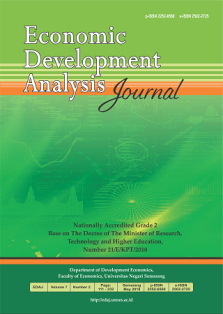Financial Literacy and Inclusion on Consumption in Indonesian Rural Communities
Abstract
Financial inclusion and literacy are government efforts to increase economic growth for the welfare of its people. The level of community welfare can be seen through household consumption expenditures. Rural communities in Indonesia have a larger number than those in urban areas. Based on these problems, this study aimed to determine the impact of rural community financial literacy and inclusion on consumption levels. The data used were based on the results of IFLS 5 in 2014 with a total sample of 1,585 individuals. The method used in the analysis was the Tobit regression model. The results showed that the variables had a significant effect on the consumption level of rural communities were ownership of savings, financial literacy, market access, income, ownership of assets in the form of houses and buildings, and age. Meanwhile, the insignificant variables were ownership of loans, poverty, and ownership of assets in the form of land. From these results, it can be seen that the consumption pattern of rural communities in Indonesia does not depend on loans, but on financial literacy, income, and market access.


